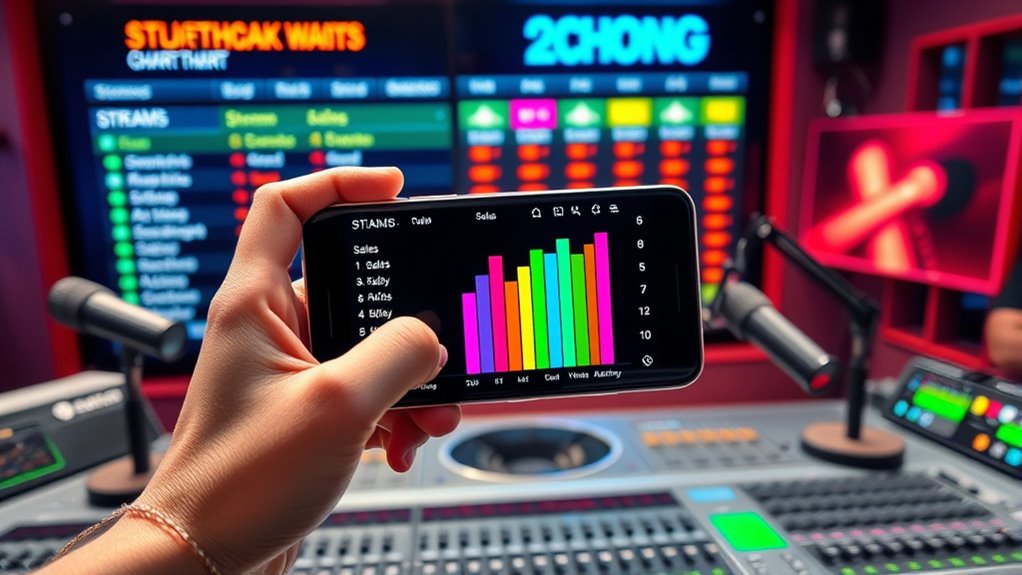Music charts rank popular songs by using a mix of data points. You’ll see streams from platforms like Spotify or YouTube, sales from stores like iTunes, and airplay on radio and TV. Together, these give a full picture of a song’s current popularity. The more streams, sales, and airplay a song gets, the higher it rises on the chart. Keep exploring to understand exactly how each factor influences the rankings.
Key Takeaways
- Music charts combine streams, sales, and airplay data to rank song popularity in real-time.
- Streaming counts from platforms like Spotify and Apple Music are weighted to influence rankings.
- Sales include digital downloads and physical copies, impacting chart positions immediately upon purchase.
- Airplay data from radio and TV monitoring services reflects how often songs are broadcasted to audiences.
- The overall chart position results from a weighted aggregation of all these factors, showing current listener engagement.

Have you ever wondered how music charts determine which songs are the biggest hits? It all comes down to a combination of factors that create a digital ranking, which is then used to compile the chart methodology. Essentially, music charts analyze various data points—streams, sales, and airplay—to produce a chart position that reflects a song’s popularity at a given moment.
Music charts use streams, sales, and airplay to rank songs’ current popularity.
The digital ranking is the core of how these charts work today. Unlike in the past, when physical sales like CDs and vinyl were the main metrics, now streaming services like Spotify, Apple Music, and YouTube play a dominant role. Each stream is assigned a certain value, and these are aggregated to calculate a song’s overall digital ranking. The chart methodology considers not just the number of streams but also the source and the type of streams, such as paid subscriptions versus ad-supported listening. This guarantees that the ranking accurately reflects genuine listener engagement rather than artificial boosts.
Sales, both physical and digital, continue to impact chart positions, though their weight has shifted over time. When you purchase a song or album through online stores like iTunes or Amazon, that sale immediately boosts the song’s ranking. Some charts also factor in bundle sales—when a song is included as part of a larger purchase or promotion—though the specifics vary depending on the chart’s rules. The combination of sales and streams offers a thorough view of a song’s reach.
Airplay, or how often a song is played on radio stations and music television, remains an indispensable element of chart calculations. Radio airplay data is collected by monitoring services that track how frequently a song is broadcast. The more a song is played, especially on popular stations, the higher its position can climb. This is especially true for charts like the Billboard Hot 100, where airplay has historically been a major factor. The integration of airplay into the overall chart methodology ensures that songs gaining widespread radio exposure are recognized, complementing streaming and sales data. Additionally, understanding the accuracy of airplay data helps clarify how charts reflect real-world listening habits.
Frequently Asked Questions
How Do Music Charts Adjust for Regional Popularity Differences?
You might wonder how charts handle regional biases, and they do so through geographic weighting. This process adjusts scores based on regional popularity, ensuring that local hits don’t overshadow global favorites. By applying geographic weighting, charts balance regional differences, giving fair recognition to songs popular in specific areas. This way, regional biases are minimized, and the chart reflects a more accurate picture of a song’s overall success across different locations.
What Role Do Social Media Trends Play in Chart Rankings?
Social media trends can dramatically influence chart rankings, acting as a double-edged sword. Viral challenges and influencer promotions boost a song’s visibility, driving streams and sales quickly. While these trends create fleeting spikes, they also help sustain a song’s momentum, pushing it higher on charts. You might notice that a catchy TikTok dance or an influencer’s endorsement can turn a song into a chart-topping hit almost overnight.
How Are Streaming Algorithms Weighted Differently Across Platforms?
Streaming algorithms are weighted differently across platforms due to platform differences in user engagement and content delivery. You’ll find that some platforms give more importance to total streams, while others prioritize unique listeners or playlist placements. These algorithm weightings impact chart rankings, making it essential for artists to understand each platform’s unique approach. By tailoring your strategies to these differences, you can maximize your streams and improve your chart performance.
Do Remixes or Alternate Versions Affect Chart Eligibility?
You might think remixes or alternate versions don’t affect chart eligibility, but they often do. The remix impact varies by chart rules; some recognize remixes as separate entries, boosting a song’s overall presence, while others combine them. Generally, if a remix is markedly different, it’s considered a new version, which can influence version eligibility and chart performance. Always check specific chart guidelines to understand how remixes are factored in.
How Often Are Chart Calculation Methodologies Reviewed or Updated?
Chart calculation methodologies are reviewed regularly, with updates to chart algorithms and methodology revisions happening periodically to guarantee fairness and accuracy. These updates typically occur every few months or quarterly, depending on industry needs and technological changes. As a listener or artist, you should stay informed about these revisions because they can influence how your favorite songs or new releases rank on the charts, reflecting the latest industry standards.
Conclusion
So, next time you see a chart topping list, remember it’s not just about the music—it’s about streams, sales, and airplay pulling the strings behind the scenes. You might think it’s all organic, but in reality, it’s a carefully choreographed dance of numbers and algorithms. Ironically, the song that hits number one might just be the one with the biggest budget for promotion, not necessarily the most authentic tune you’d want to listen to forever.







